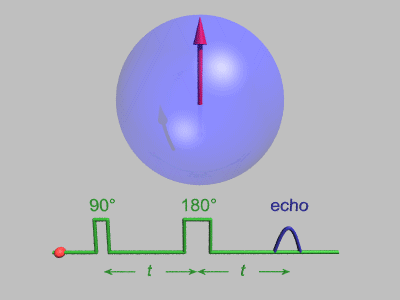Spin echo

In physics , the spin echo is an effect of quantum mechanics that is used in the areas of nuclear magnetic resonance (NMR) and electron spin resonance (ESR), in particular for measuring magnetic relaxation times .
Certain particles, such as electrons and certain atomic nuclei, have a quantum mechanical property of their own angular momentum , which is referred to as spin . Because of their electrical charge, the spin is accompanied by a magnetic dipole moment , so that the particles in a static magnetic field have different energies depending on the setting angle. A macroscopic magnetization of the material sample then arises from the fact that more particles align themselves along the field direction than in the opposite direction. It lies parallel to the field, but can be rotated away from the direction of the field by an additional alternating magnetic field of a suitable frequency, whereby its setting angle increases proportionally with a longer exposure time of the alternating field. The static field then acts with a torque which alone would set the magnetization parallel again, but if the particle has an angular momentum it causes the Larmor precession around the field direction. The component of the magnetization, which is perpendicular to the axis of the static field, rotates around this axis and induces an alternating voltage in another magnet coil, just like the rotating magnet in an electrical generator. The frequency of this alternating voltage is the Larmor frequency in the static field and its amplitude is proportional to the strength of the rotating component of the magnetization. Since you have to give the same frequency to the alternating field in order to twist the magnetization against the direction of the field, it is a resonance phenomenon .
For the spin echo, the alternating field is now switched on for so long that the magnetization is rotated by 90 ° ( -pulse), i.e. is perpendicular to the direction of the static magnetic field. During the subsequent Larmor precession, the magnetization u. a. because the (temporally) static magnetic field is somewhat inhomogeneous, i.e. H. spatially varied. Then the individual spins do not all rotate at the same speed; one speaks of the dephasing of the spins. As a result, the rotating component of the magnetization decreases, practically down to zero. After a while, the alternating field is switched on for twice as long as before, so that the spins are rotated by 180 ° ( -pulse). Then they stand again perpendicular to the static field and continue their Larmor precession in the same sense, but the slower ones among them now have a head start over the faster ones. Due to the same inhomogeneities of the static field, the spins “converge” again ( rephasing ) so that after the same period of time between the - and the - pulse of the alternating field, they are again in phase and generate a clear maximum of the induced signal , the so-called spin echo.
During this process, however, some of the spins will realign themselves to the static magnetic field and thus no longer contribute to the transverse magnetization. The echo is therefore weaker than with the initial magnetization. The time constant of this decay is the transverse relaxation time . It can either be determined in several experiments with different echo times, or by applying further pulses at regular intervals after the first spin echo , so that a large number of spin echoes can be observed one after the other, which weaker from time to time fail. The latter method, the so-called Carr - Purcell pulse sequence, is characterized not only by its speed but also by its insensitivity to diffusion processes.
The spin echo is used in magnetic resonance spectroscopy and magnetic resonance tomography , since different atomic nuclei , i.e. different isotopes , and even atoms in different compounds have different relaxation times. This enables connections to be examined in detail or types of tissue to be differentiated in tomography.
A very important and widespread application of the spin echo experiment is the measurement of diffusion and flow movements using field gradient NMR . The diffusive or (in the case of flux) coherent movement of particles in a magnetic field gradient over the nuclear spin precession phase is measured in the spin echo experiment. Thus one can also physically and chemically identical species, e.g. B. differentiate certain water molecules in water and study their diffusion, which in this case is called "self-diffusion" .
literature
- Hook , Wolf : Atomic and Quantum Physics. , Springer textbook, ISBN 3-540-67453-5 ( limited preview in Google book search)
Individual evidence
- ^ Paul T. Callaghan Principles of Nuclear Magnetic Resonance Microscopy . Clarendon Press, Oxford 1991, ISBN 0-19-853997-5 limited preview in Google Book Search

